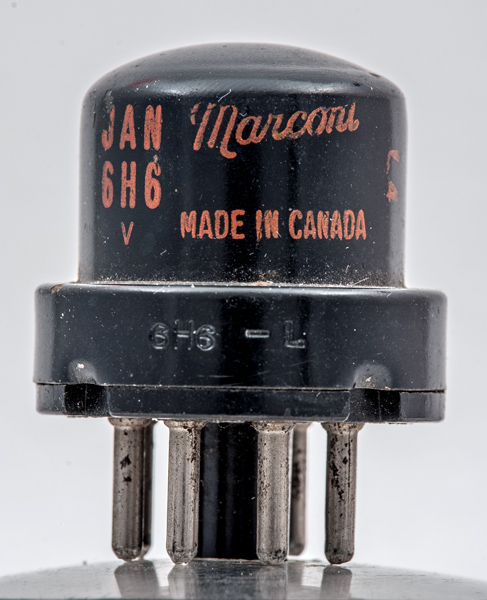|

This sequence of exhibits makes interesting comparison. Notice first that 6H6 is actually marked as 'GT/G' and is the odd one out internally. The other three glass specimens 6H6, 6H6 & 6H6 are identical, all made on the same production line, although marked differently. All three also conform to 'GT/G' dimensions.
Now the metal specimen 6H6: it is shorter but its base cap diameter is larger (34 mm) so that it would not fit into a socket with a skirt designed to hold a compact screening can. Of course, a metal valve would not require an external screening can but in some applications the glass ones did. It all goes to show that the famous Octal series, in which all manufacturers used the same type numbers for supposedly interchangeable valves did not, in reality, guarantee interchangeability after all. You had to look carefully at the suffices and even then there was little consistency.
A particular problem with 6H6s was using unshielded glass types to replace metal types when the latter were not available, they were made only in the US and (later) in the Soviet Union. Some manufacturers of glass equivalents supplied them with metallised coatings for this reason.
The original metal 6H6 dates from the mid 1930s and was intended as a general-purpose double diode capable of any application from power rectification to VHF signal detection. The maximum ratings were uprated during its manufacturing life but ratings of up to 420V PIV and 48 mA peak per cathode are given by (1940s) RCA sources. It may seem odd that the 6H6 was regarded as a HT rectifier but because it had separate cathodes and a heater-cathode insulation rating of 330V (pk) this valve and its brother the 12H6 could be very handy as a transformerless voltage-doubler rectifier to give around 250V DC at 8 mA. Not enough for a domestic radio but, in days when there were no silicon diodes, just the job for auxiliary supplies of 2 W of less.
Not all glass equivalents could equal the performance of the metal version. In particular, the 'pinchless' construction of the metal type, with very short leadouts, made it useful as a detector up to TV frequencies. However, very nearly all military WWII applications were less demanding so the wide variety of glass types coped 'well enough'. Very large numbers of glass 6H6s were released onto the surplus market after the war and are still very common. Far fewer metal versions were released and they remain in demand up to the present day.
|